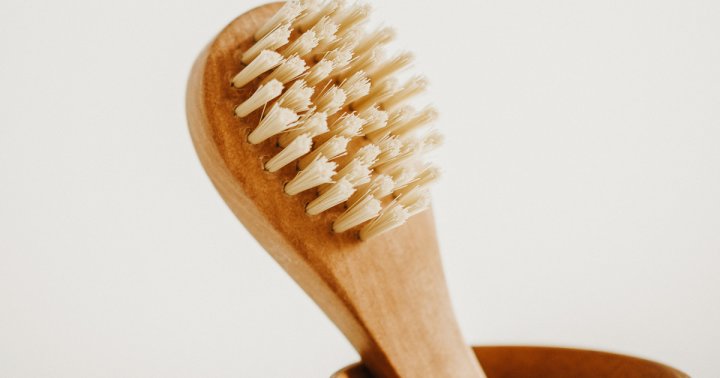Dry Brushing Is Great For The Skin — Just Don't Make This Common Mistake
Here's what you need to know.

You need to clean your beauty tools. All of them! Keeping your tools spick and span not only prevents bacteria from transferring onto your skin (gross) but also helps them function at their best—when your beauty tools accumulate grime, they just don’t work as well.
You may know when it’s time to give your makeup brushes a good scrub (at least once a week), but some unsuspecting tools fly under the radar. For example, do you know how to clean your hot tools? What about ridding your hairbrush of debris? And finally: Did you know your dry brush can get gunky?
If you’re wondering about that last one, you’ve come to the right place. Below, find exactly how (and how often) to clean your dry brush.
How to clean your dry brush.
Dry brushing comes with a host of benefits (make sure to check out our full guide, if you need a refresher). “It boosts circulation and stimulates the skin, as you start off at the feet and brush toward your heart,” triple board-certified dermatologist Mamina Turegano, M.D., FAAD, says on an episode of Clean Beauty School, and it serves as a grounding moment of self-care. “You're paying attention to parts of your body that you might not normally pay attention to regularly. We don't really touch our skin–and doing so can be an excellent form of self-care. It's important to acknowledge your skin. It can be very nurturing and healthy,” Turegano adds.
But dry brushing is also an excellent physical exfoliant for the body since those bristles can buff away excess dead skin cells from the surface of your skin. As the brush manually lifts that dead skin, those flakes can become lodged in the bristles and build up—so, yes, you need to give your dry brush a good clean every once in a while, even though you’re sweeping over dry skin.
The good news is, cleaning your dry brush is super easy: Simply scrub the tool with warm water and a gentle soap or makeup brush cleanser. Make sure to set it out to dry with the bristles facing up, so they don’t collect any mildew or bacteria. If you’d like to clean your dry brush in between washes, feel free to mist it with a tea tree solution (1 part tea tree oil, 2 parts water), as the essential oil has antifungal and antibacterial properties.
In terms of how often you should clean it, it really depends on how often you use it. Some practice full-body brushing daily or every other day, which means you may have to clean the tool more regularly (like once a week). Others only do it once or twice a week, and if you’re dry brushing your face, you definitely shouldn’t make it a daily habit (that’s way too much exfoliation for your delicate facial skin). If you do have space between your sessions, you may only need to clean the tool every few weeks or so. No matter what, make sure you carve out some cleaning time every once in a while or replace the tool after its prime. Here’s a list of our favorites, if you’re in the market.
Should you clean your dry brush? Absolutely—all of your beauty tools deserve a good scrub, since they can accumulate dirt and grime over time. Dry brushes don’t need a ton of maintenance; a gentle soap or makeup brush cleanser will keep the tool in tip-top shape.

 JaneWalter
JaneWalter 
































